OnePlus One Review
OnePlus One is the maiden Android phone manufactured by OnePlus, a Chinese startup company. This stylish phone features quality hardware and Android ROM CyanogenMod. With a $300 price tag, it is easily one of the best deals on the market. The manufacturer crammed up top-of-the-line hardware into a slim body, then fitted it with useful software and selling it for half the price of other competing devices. There is an invitation system required to purchase this phone. One can ask someone who has bought an OnePlus for an invite or one can enter contests or promotional events.
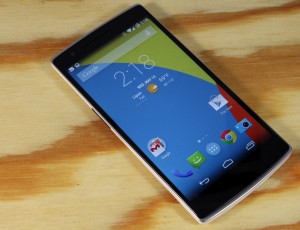
Specifications
Processor: 2.5 GHz quad-core Qualcomm Snapdragon 801
GPU: Adreno 330
OS: CyanogenMod 11s – Android 4.4.2
Network compatibility: GSM-LTE, unlocked (Micro SIM)
Memory: 3GB RAM, 16 GB storage
Display: 5.5” IPS LCD 1920×1080 (401 dpi)
Camera: 13 MP rear, 5 MP front
Battery: 3100mAh, non-removable
Wireless: Wi-Fi A/B/G/N/AC (dual band support), NFC, Bluetooth 4.0
Thickness: 8.9 mm
Weight: 162 g
Price: $299 (16 GB), $349 (64 GB)

Body
Though, it may seem conservative from a stylish point of view, it doesn’t change the status quo of the big-screen phones that dominate the Smartphone industry. With a standard plastic body a big 5.5” screen and 13 MP camera, OnePlus shines in many categories. The One is much sturdier than other polycarbonate phones such as Galaxy S4 or Nexus 5. The white back on the 16 GB model can be removed and its 3100mAh capacity battery is fixed in place. The screen is made of black Gorilla Glass. The buttons are too thin and it’s hard to hit with a thick finger. The Gorilla glass black pane screen floats on a bezel made of a separate piece of plastic painted chrome. Multicolor LED notification light hides next to the front-facing camera. Capacitive menu, home, and back buttons are located beneath the screen. The weak backlight disappears in any strong light and the user would have to look hard to find these buttons. Some functions of the default layout could be changed using the CyanogenMod. With a single press, the menu button can be switched to activate the Recent views. Long-tap actions to the home and menu buttons can be assigned, as well as Samsung-style double-tap for the home button.
Users can also opt for a Nexus-style on-screen navigation bar and ignore the physical buttons completely. When the virtual nav bar is enabled, the capacitive buttons ignore all input, and become all but invisible with the backlight disabled. The virtual buttons can be added, subtracted, and re-arranged.
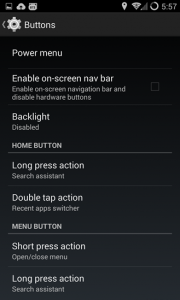
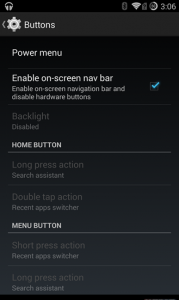
Display
The 5.5” screen makes OnePlus the “two hand” phone, though the slim body and beveled back will allow users some of the functions using one hand. The larger screen helps with the videos and internet browsing. The 1080 LCD panel isn’t the best, but it’s not the worst either. Colors are bright and the 5.5” screen matches well with the resolution. It won’t disappoint anyone who prefers a big screen in a thin body. For a low budget phone, its maximum and minimum brightness are separated nicely. Even though the auto brightness feature is bit too dim outdoors, it could be manually adjusted for its CyanogenMod.

Camera
The downside of this phone is the camera which produces washed-out photos with poor contrast between light and dark areas. The reason for this is a lot of pixels (13 MP) have been shoved into a tiny camera. Video also washes out bright spots and ignore darker ones. The lack of optical image stabilization may not hurt taking still images, but its more apparent in video. A selfie taker will love this phone because of its 5 MP front camera.
The good sides
OnePlus has the most powerful hardware available among $300-$350 range phones.
Great build quality
CyanogenMod adds a ton of options and settings that will please power users
Its impressive battery will last for 2 days with heavy WiFi use and at least one day on 3G or LTE use.

The bad sides
The underperforming camera is definitely the most disappointing hardware feature on the phone
The phone slightly too big to operate with one hand
The battery isn’t removable and there is no Micro SD slot
The invitation system required for purchase is a joke
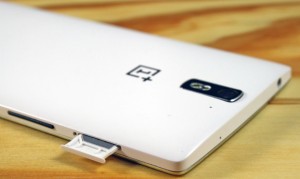
Performance
The specifications on this phone will meet or beat any similar phone in the market. With Qualcomm Snapdragon 801 processor with four cores, its processor has a top speed of 2.5 GHz. Paired to 3GB of Ram and an Adreno 330 GPU. CyanogenMod’s relatively light RAM load keeps the phone humming along flawlessly. OnePlus is champ in everyday tasks. No slowdown or dropped frame can found in this phone. Recording 1080p video is really smooth and game playing looks better on this phone than on any other similar devices.

Audio and reception
The phone has two real stereo speakers which are placed on the phone’s edge, meaning they’re audible whether the phone is faced down or faced up. The speakers are very loud – about 1.5 times louder when comparing to the speakers on DROID MAXX. Reception is pretty good even in a remote location. When in the city, a reliable LTE signal can be received indoors or outdoors while the speed matches the connection. The soft earpiece above the screen makes it hard to hear the other party even when in a quiet room. OnePlus fixed the issue with a software update and it was much better than before.
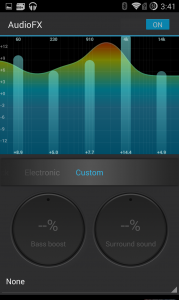
Battery and storage
The 3100mAh battery will last more than a day, even with a lot of browsing via WiFi. The model with 16 GB storage doesn’t offer Micro SD card slot but the 64 GB model with a price tag of $50 more provides the ease of extra storage.
Software
The software is CyanogenMod 11, which is a customized version of Android 4.4.2. It is a pure Android in most respects, which enables power users dig through its many advanced options. With the latest version of Android and the promise of faster updates, OnePlus has more options than many other similar phones.
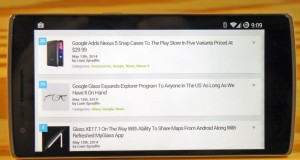
Interface
When the latest build of CyanogenMod 11 was loaded on a Nexus 5, the first noticeable change was the lockscreen which abandoned Android’s semi-translucent one for a cyanogen-colored slab that slides down to unlock or to the side for the camera. 11S’s more fine grain control over themes than standard CyanogenMod, allows users to apply an entire theme, or overall style, icons, fonts, wallpapers, boot animations, or even sounds as they prefer. OnePlus also does some interesting interface tricks. The wake-to-launch feature allows the user to train the phone to awaken to a command. But, the command the user must use is “Hey Snapdragon,” which seems like a promotional tool for Qualcomm than an actual feature add. The more useful feature is the ability to wake the phone with taps and gestures. Double tap enables the wake option and more ways of commanding the phone while it’s off can be found inside the Interface menu. A two-finger upward swipe can be used to play of pause music and left or right arrows can be used to go forward or back. A “V” motion activates the flashlight. The gestures rely on capacitive inputs and not vibrations. As a result, music can be turned on while the phone is inside user’s pocket. This feature needs to be combined with standard proximity detection to make it truly useful.

Apps
The phone has some interesting apps that aren’t part of the CyanogenMod stable. AudioFX, a swankier version of the basic equalizer app replaces the familiar DSP Manager. There is a slight alteration in the camera feature. Instead of a long-press to open up various manual controls, they can be opened by more conventional virtual buttons. Swiping down will let users scroll through various scene and image options. Customized versions of Android apps like the home screen and calculator are present, but the customized Apollo music player is not present.
Other features
Out of many features of CyanogenMod, a selected few are listed below:
Customizable navigation buttons
Customizable pull-down quick settings menu
Samsung style notification tray settings
Settings profiles and reboot options in the power menu
OnePlus One’s software is quite attractive for someone who prefers a customizable phone that runs the latest version of Android.
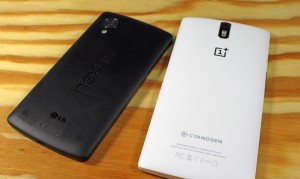
Verdict
Considering the staggering low price of $299, this phone is amazingly powerful and versatile. At approximately half the cost of flagship devices from Samsung, HTC, Sony and LG, the One really is the best deal in town. Even though the Nexus 5 could be bought for a few dollars more, OnePlus’s build quality, screen, camera, processor, RAM, and camera beats Nexus 5. Anybody looking for an unlocked GSM phone would be compelled by its software and updates from CyanogenMod. The underperformance of its camera is overshadowed by its fantastic specs impressive battery life and excellent build quality. When considering the hardware and the software, OnePlus is definitely the best deal around for a high-end device. 64GB version of the OnePlus One with a price tag of $350 is entirely reasonable and amazing value.
OnePlus is using and invitation system for people wanting to buy it. Though, OnePlus claims that this system was introduced to reward loyal fans and cut the middlemen, many consumers find the invitation system very insulting. Some critics are calling it an attempt at fake exclusivity and hype.

Feel free to comment about your own experiece with OnePlus one phone in the comment section below
SA
[embedyt] https://www.youtube.com/watch?v=FrgGHAab9D8[/embedyt]






